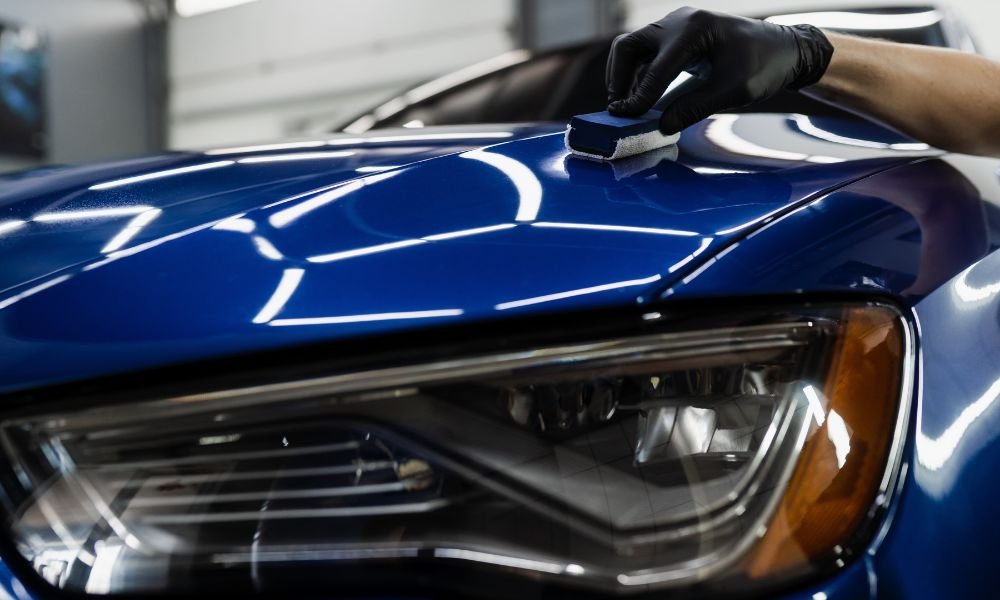Why Ceramic Covering Is the Ultimate Remedy for a Remarkable Finish
Ceramic coating has become a leading service for those looking for a flawless finish for their automobiles, many thanks to its exceptional sturdiness and protective functions. This sophisticated liquid polymer not only bonds perfectly with manufacturing facility paint but also offers a formidable barrier versus common risks such as scrapes, UV rays, and ecological pollutants. Its hydrophobic buildings streamline upkeep while improving visual appeal. Nevertheless, recognizing exactly how this innovation compares to typical techniques and exploring its application subtleties can expose even more about its worth. What aspects truly established ceramic covering apart?
What Is Ceramic Finish?

When used properly, ceramic covering creates a hydrophobic surface that wards off water and dirt, making it easier to keep and clean. Unlike standard waxes or sealants, which commonly supply short-lived security, ceramic finishes can last for numerous years, depending upon the item top quality and application technique. The procedure of using ceramic covering requires careful preparation, including extensive cleaning and often repaint modification, to ensure optimal bonding and efficiency.
Ceramic coverings are not restricted to auto surfaces; they can likewise be utilized on various materials, including glass, steel, and plastics, offering a functional solution for boosting protection. In general, ceramic finishing stands for a substantial innovation in surface protection technology, integrating both visual and practical advantages for a vast array of applications.
Benefits of Ceramic Finishing
While lots of surface protection choices exist, the benefits of ceramic finish stand apart as a result of its special residential properties and durable efficiency. One of the main advantages is its extraordinary durability. Ceramic Coating Philadelphia. Unlike conventional wax or sealers that need regular reapplication, ceramic coverings provide a resilient layer that can last for a number of years, dramatically minimizing upkeep initiatives
One more notable benefit is boosted protection versus ecological contaminants. Ceramic coatings create a hydrophobic surface area that repels water, dirt, and various contaminants, making it simpler to clean up. This attribute not just preserves the car's appearance however also lessens the threat of deterioration and oxidation, especially in severe weather.
Furthermore, ceramic coatings use remarkable resistance to UV rays, preventing fading and degradation of paint with time. This UV protection is essential for preserving the aesthetic worth of surface areas and cars revealed to direct sunlight.
Additionally, the glossy surface accomplished with ceramic coating improves the general visual allure, offering surfaces a showroom-quality luster. On the whole, ceramic coverings stand for a substantial advancement in surface area protection innovation, providing long-lasting advantages that deal with both functional and visual demands.
Just How It Functions
Understanding the science behind ceramic finishings exposes how they provide such remarkable protection and durability. At its core, a ceramic covering is a fluid polymer that chemically bonds with the car's manufacturing facility paint. This bonding produces a find this protective layer that is both oleophobic and hydrophobic, repelling water, dirt, and oil. The primary part of the majority of ceramic finishes is silicon dioxide (SiO2), which is obtained from quartz. This compound adds to the coating's hardness and resistance to scrapes, UV rays, and ecological pollutants.
The application process includes several actions, including surface area prep work, which is crucial to attaining ideal adhesion. Once applied, the finishing goes through a curing process, throughout which it solidifies and creates a semi-permanent bond with the paint surface area. This bond Read More Here is what distinguishes ceramic layers from standard waxes and sealers, offering a longer-lasting safety obstacle that can sustain for many years.
Furthermore, the density of the covering can enhance its safety qualities, making certain that it can endure severe problems. Inevitably, the scientific research of ceramic finishings integrates sophisticated products with cutting-edge application methods to supply an exceptional degree of defense and visual enhancement for automobiles.
Contrast With Conventional Methods
The benefits of ceramic coatings become especially noticeable when contrasted to conventional paint security approaches such as waxes and sealants. While waxes supply a momentary shine, commonly lasting a few weeks to a couple of months, ceramic finishes give a durable protective layer that can withstand for several years. This longevity substantially minimizes the frequency of reapplication, making ceramic finishings an extra cost-effective solution in time.
Additionally, typical techniques frequently require substantial preparation and several applications to achieve a sufficient level of protection. On the other hand, ceramic finishings bond at a molecular degree with the automobile's surface area, developing a robust guard against environmental pollutants like UV rays, acid rain, and roadway salts. This bond improves the car's resistance to scratches and swirl marks, which prevail with conventional waxes and sealants.
Furthermore, the hydrophobic homes of ceramic finishes push back water and dirt, resulting in easier cleaning and maintenance. In contrast, wax and sealant-treated surfaces can draw in grime, necessitating more frequent washing - Ceramic Coating Philadelphia. In general, ceramic coatings not only give remarkable defense however additionally supply an extra visually attractive and long-lasting coating, developing them as the recommended choice for critical automobile owners
Application and Upkeep Tips

Making use of a foam applicator, use the finish in little sections, adhering to the maker's standards relating to thickness and overlap. Permit adequate curing time between coats, usually 24-hour, to make sure appropriate bonding. After application, it is crucial to prevent exposure to water or harsh components for at the very least a week to permit the covering to totally treat.
For maintenance, clean the automobile frequently with pH-balanced soaps and avoid unpleasant products. Touchless vehicle cleans are suggested to lessen scraping. Additionally, using a ceramic maintenance spray can enhance the covering's hydrophobic residential or commercial properties and longevity. Routine examinations for any type of signs of wear will certainly aid keep the finish's stability and preserve that pristine surface.
Verdict
In final thought, ceramic finish arises as a premium option for attaining a flawless automotive coating. By developing a durable bond with manufacturing facility paint, ceramic finishing efficiently shields against scratches, UV rays, and environmental contaminants.
